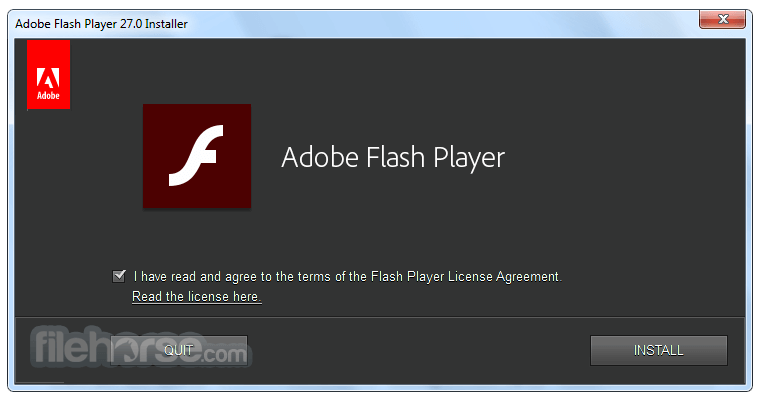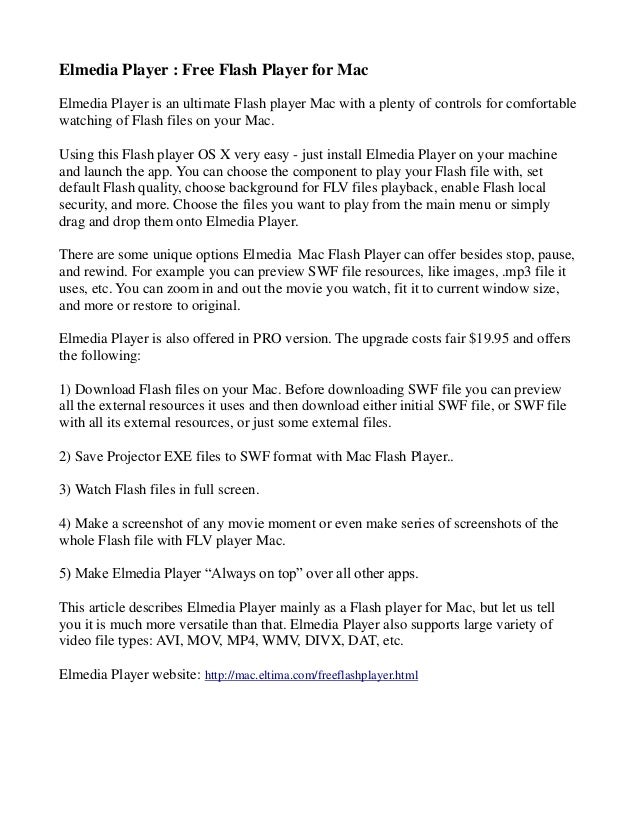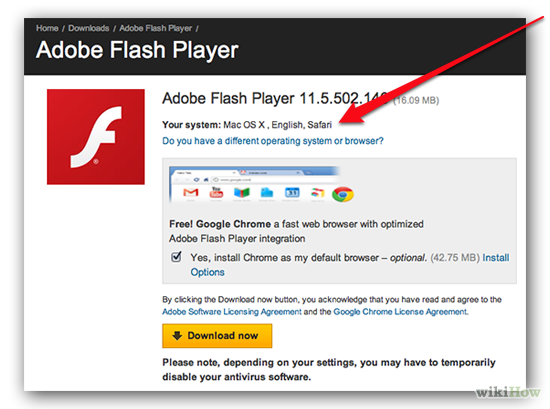- Adobe Flash For Mac Safari
- Download Adobe Flash On Mac
- Play Flash On Mac
- Downloading Flash On Mac Os
- Adobe Flash
Best apps live in Setapp
Two ways to capture Flash videos on Mac are provided: 1 Click the 'Download' button that appears on the top right corner of the video to save the video in one click. 2 Copy the video's URL from the browser and then click '+ Paste URL' in the left side of the program's main interface. The program will automatically download the target video. Answer: A: Answer: A: - Insert the USB flash drive into one of the Mac's USB ports. Open the Finder app and the USB flash drive should be listed under Devices on the left side. Click on it and and y will see the drive file system the right hand side. Navigate to wharer y wabnt to go and cop and paste files. Two ways to capture Flash videos on Mac are provided: 1 Click the 'Download' button that appears on the top right corner of the video to save the video in one click. 2 Copy the video's URL from the browser and then click '+ Paste URL' in the left side of the program's main interface. The program will automatically download the target video.
By the simple virtue of browsing the web over the years, nearly all of us have seen a variety of pop-ups asking us to download or upgrade Flash Player for Mac. Usually, there’s little explanation involved, which leaves you thinking, “Do I really need to install Adobe Flash Player on Mac?”
Adobe Flash is a proprietary software that started in the late ‘90s as a way to include advanced interactivity, gaming functionality, and video capability into your browser. By the early 2000s, Flash was supported by every major browser and seemingly ran the internet. That is until Steve Jobs himself declared a war on it.
In a press release published by Apple in 2010, Steve Jobs laid out his reasons for not integrating Adobe Flash in the Safari browser by default. His main criticisms of the platform were its closed proprietary nature, slow updates, weak security, and increasing availability of open standards that were arguably better equipped to handle browser interactivity.
For a long time, Adobe Flash security issues were the primary reason most developers discouraged people from installing the application. As you may have noticed, oftentimes Adobe Flash Player download for Mac pop-ups haunt you on the least trustworthy websites. It’s highly likely that those were hackers using Adobe Flash installers to find a way into your system.
Fortunately, in the last 10 years, the popularity of Adobe Flash has decreased significantly. By now, 95% of all websites have switched to the open HTML5 standard. This even includes all the major video companies, such as Vimeo, Netflix, Facebook, and YouTube. In fact, the popularity of the Flash technology has declined so much now that Adobe decided to end its Flash support in 2020.
So is Adobe Flash Player safe? Generally, yes, given that you download Flash Player for Mac from Adobe’s official website. And sometimes there is no way around installing Flash as you might still need it to run that lagging 5% of the web properly. Whatever the reason, below we’ll discuss how to manage Adobe Flash safely and securely.
Mac problem that needs a quick fix?
Get Setapp and install 150+ apps in one pack, a solution catering for every issue you have with your Mac.

How To Install Adobe Flash Player On Mac
If you absolutely need to download Adobe Flash Player for Mac, you should at the very least do it securely. Good tips to note are install Flash only when required, disable it when not in use, update it regularly to get the latest security patches, and delete it completely as soon as you can make the full switch to more modern web technologies.
Safely install Adobe Flash Player on Mac
If there would be only one takeaway from reading this article, it should be: never ever download Flash Player for Mac from unrecognized websites.
Using Macs in general is very safe. But by far the most popular way for hackers to get into your system is to persuade you to download malware that’s masking itself as a well-known program. And Flash Player for Mac tops the list, having the worst security record out of any software. Moreover, Adobe Flash is the number one reason Macs crash overall.
So when you are about to install Adobe Flash Player on Mac, you should:
Go to get.adobe.com/flashplayer (this is the only official Flash Player for Mac distributor)
Click “Download now”
Navigate to your Downloads folder and open the .dmg file
Proceed through the installation instructions
Restart the browser, after which Adobe Flash Player for Mac should be activated
Update Adobe Flash Player for Mac regularly
Once you have Flash Player installed, you need to remember to update it regularly (e.g. once a month) to avoid any security issues. To check whether there’s a new version of Flash available:
Open System Preferences
Click on the Flash Player and navigate to the Updates tab
Select Check Now or Install Now if there’s an update available
Disable Flash when not in use
When you encounter a website that doesn’t work properly without Flash, proceed to install the player from the official (very important) website as per the steps above. But for complete security, turn off Flash right after you use it and enable it only when there’s no workaround.
To disable Flash Player for Mac in Safari:

Go to Preferences and then Websites
Scroll down to Plug-ins and uncheck the Adobe Flash Player
Similarly, disabling Flash can be done in Content Settings in Chrome and Addons > Plugins in Firefox.
Adobe Flash For Mac Safari
Completely uninstall Flash Player for Mac
There’s a lot of confusion with regards to deleting Flash Player. As we’ve seen, when you download Flash Player for Mac, it doesn’t install itself as an app, but rather integrates into your System Preferences.
Hence removing Flash Player is not as easy as just dragging it to the Trash. Adobe has a whole page devoted to the uninstallation process and makes you download a separate tool to delete Flash properly.
To remove Flash Player the Adobe way:
Download the uninstaller for your macOS
Launch it as any app and follow the instructions
Restart your Mac
However, due to the Flash Player’s pervasive presence on your Mac, it’s highly recommended that you use a professional third-party uninstaller like CleanMyMac X.
Get a pro uninstaller for Mac
With CleanMyMac X, unneeded software and junk will be gone from your computer in a single cleanup. An all-mighty cleaner that deserves your attention.

To uninstall Adobe Flash Player on Mac with CleanMyMac X:
Navigate to the Uninstaller tab
Select Adobe from Vendors
Check the box next to Flash Player and click Uninstall
Recover files lost to Flash Player
Sometimes you simply can’t prevent the malware from getting into your system. And most of the time you only realize that infiltration happened after the fact, when you discover some of your files completely gone.
Good news is you might be able to recover your files if you act quickly. As soon as you notice any files missing, install a professional Mac recovery app like Disk Drill and follow this process:
Launch Disk Drill app from Applications
Find your hard drive in the list and click Recover
Choose one of the recommended options, from disabling system protection to connecting another Mac, to allow Disk Drill to recover lost files
Finally, to stop compromised apps or files from getting into your system, use a malware protection utility in CleanMyMac X on a regular basis.
To scan your Mac for viruses with CleanMyMac X:

Download Adobe Flash On Mac
Select the Malware Removal tab
Click Scan
Delete anything suspicious that shows up in the report
Overall, there are very few reasons to download Flash Player for Mac today. Nearly all modern websites have switched to community-supported standards like HTML5, CSS3, and JavaScript. But if you need to use Flash, make sure to download it from the official source and turn it off when not required to protect yourself from its security flaws.

In addition, make sure you’re fully protected from any worst-case scenarios by checking for malware with CleanMyMac X and recovering lost files with Disk Drill. And if you use Google Chrome, you can avoid Adobe Flash Player download for Mac altogether as it comes pre-installed in the browser.
Don’t feel like spending money on buying all the professional apps? Both CleanMyMac X and Disk Drill are available for you to try for free, along with more than 150 high-end Mac apps and utilities, through Setapp — the best platform for curated Mac apps. Adobe Flash might be on its way out, but in the meantime, you should definitely verify that you’ve been using it responsibly all this time.
Adobe Flash is now 'End of Life'
As of December 31, 2020, Adobe has stopped supporting Flash Player. It's no longer possible to download it from Adobe's website and Adobe won't be releasing any new versions or security fixes for it.
Additionally, as of January 12, 2021, even if you have Flash Player already installed, it won't run Flash files any more, thus rendering it completely 'End of Life'.
This guide will guide you through the process of downloading and installing Adobe Flash on Mac OS X.
Play Flash On Mac
Please note: the version numbers shown in these screenshots reflect the latest version at the time these guides were made; in time these version numbers will become out of date; so please don't get confused by this!
Downloading Flash On Mac Os
Visit Adobe's site and download the installer
To install Flash you must first download the installer program from Adobe.
Visit Adobe's 'Get Flash' page: https://get.adobe.com/flashplayer/
Click the 'Download now' button.
If you are using Safari, Safari will automatically start downloading the installer to your Downloads directory. If you use a different browser, it may prompt you where to save the file.
The installer will then download to your computer.
Unpack and run the installer
Depending on which web browser you're using and your browser's configuration, your browser may automatically open the '.dmg' file which was just downloaded.
If it doesn't automatically open, once the download has completed, open your Downloads folder and find the 'dmg' installer file.
Ensure that it is actually the same file you just downloaded from Adobe. Double click it to mount/open the installer container.
The 'dmg' container file you have downloaded from Adobe contains the installer program. Double click it to run the installer.
You will be prompted if you really want to run the 'Install Adobe Flash Player' program. Read the prompt carefully to ensure that you are actually running the file you just downloaded. Check the file name and the date and time it was downloaded. When you are ready, click the 'Open' button.
The Flash Installer program will now run. You are then prompted to read and agree with the Terms and Conditions. When you have done that, click to tick the checkbox and then click the 'Install' button.
The installer program will need to put system files on your computer and by default it will not have permission to do this. To grant the installer program permission to modify and create system files you need to enter your username and password and then click the 'OK' button.
Adobe Flash Player will now install itself.
Allow Flash to check for updates
Adobe Flash is able to regularly check with Adobe if there is a newer version of Flash available to download.
Flash has been found to be vulnerable to a number of serious security problems, so now more than ever it is a good idea to let Flash check for updates.
Be aware that this means Flash will occasionally connect to Adobe's servers to see if there is a new version.
Either of the first two options presented is fine. The first one ('Allow Adobe to install updates') means that any newer versions of Flash will automatically download and install themselves.
Some users may be a bit hesitant about letting software automatically download new versions and install themselves, so they may instead choose 'Notify me to install updates'. In this case, Flash Player will still check for updates to itself so that you still are aware that there is a new version, but it won't automatically install the updates; you will be prompted to easily download and install it with your consent.
Flash is now installed
Congratulations, you have now installed Adobe Flash.
Remember to always keep Flash up to date to help keep yourself safe and secure online.
You can always check if Flash is up to date by visiting the WhatIsMyBrowser.com homepage.